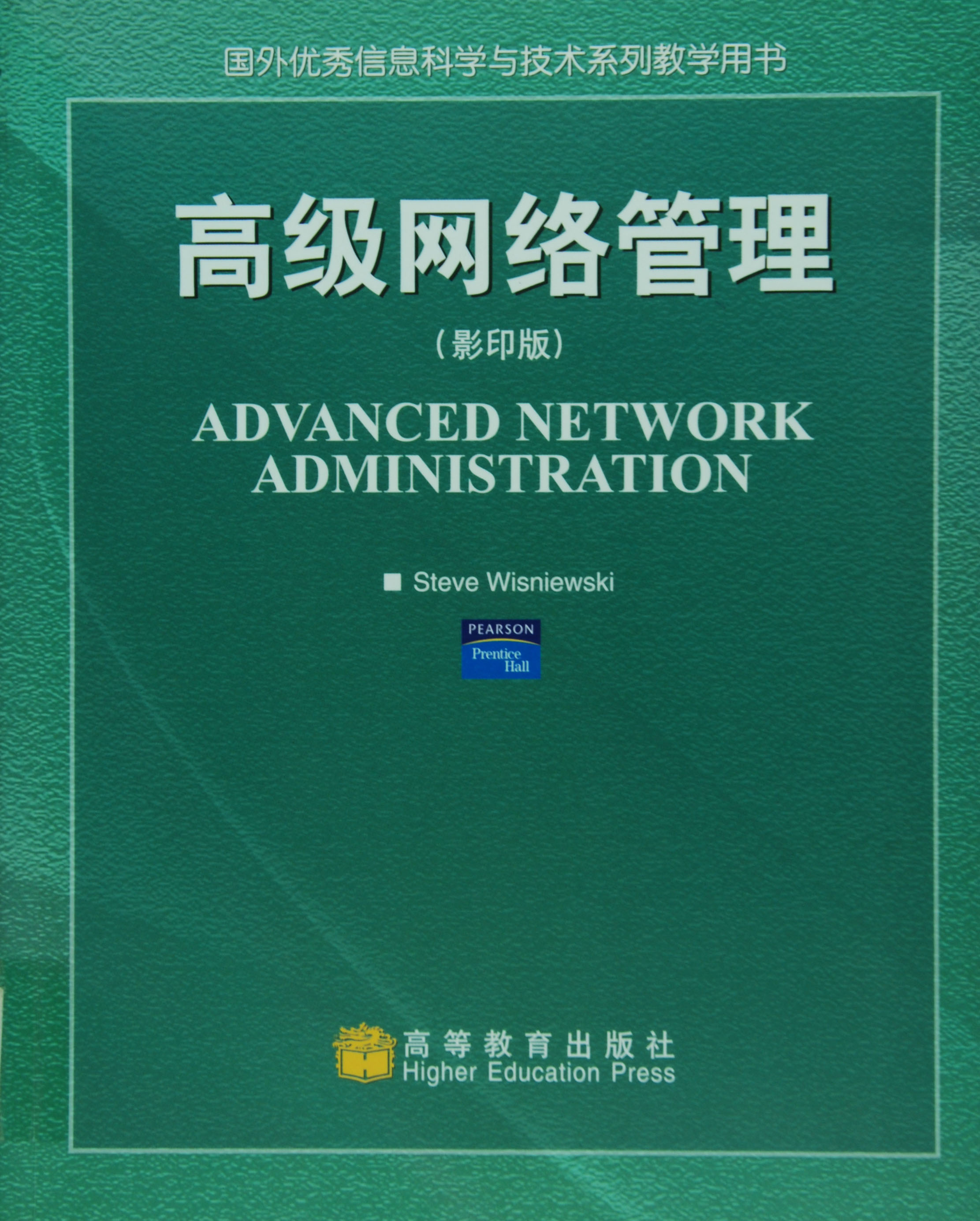高级网络管理(影印版)
作者: Steve Wisniewski
出版时间:2004-08
出版社:高等教育出版社
- 高等教育出版社
- 9787040151107
- 1版
- 88344
- 48260975-7
- 平装
- 异16开
- 2004-08
- 1230
- 1028
- 工学
- 计算机类
- TP393.07
- 计算机科学与技术
- 本科 研究生及以上
《高级网络管理(影印版)》由Steve Wisniewski著,Despite all the advances in technology,the old reliable architectures and protocolsare still being implemented in the internetworking arena today because they haveproven tO be reliable and have worked with many different products.Advanced Net-work Administration covers the concepts of routing,bridging,switching,and networkmanagement.This book iS recommended for novices who wish to further their knowl-edge ofinternetwork design.Chapters 1-3,OSI InternetworkingBasics,BridgingandSwitchingFundamentah,andRoutingBasics,shouldbetaughtas aunit.Chapters4 and5 cover Network ManagementFundamentals and Simple Network Management Proto-col.From Chapters 6 to 10,each of the main network architectures,along with thevarious protocols that comprise these architectures.are exposed.Chapters 11 and 12depart from the architectural viewpoint and discuss/nterdomain Routing Basics.OpenShortest Path First,explained in Chapter 11(OSPF),and Border Gateway Protocol,discussed in Chapter 12(BGP),are the main protocols being used in the Internet toprovide reliable routing from host to host.These two chapters should be tau#t as aunit.Chapter 1 3,Advanced IP Routing,provides a brief explanation of IP addressingand more advanced concepts such as VLSM andⅥANS,along with route summarization and redistribution.For a more thorough explanation on IP addressing refer toChapter 9,Digital Network Architecture(DNA)DEcnCt Phase IV.
Chapter 14 discusses Data Link Protocols and their importance in internet-working.Chapter 15,Internetworking Design Basics,is the capstone chapter dis-cussing how to design an internetwork using routmg and switching methods.
CHAPTER 1 Internetworking Basics
Introduction
What Is an Internetwork?
The History of Internetworking
Internetworking Challenges
The Open System Interconnect (OSI) Reference Model
OSI Information Formats
The International Organization for Standardization (IOS) Hierarchy of Networks
Connection Oriented and Connectionless Network Services
Internetwork Addressing
Comparing Hierarchical and Flat Address Space
Flow Control, Error Checking, and Multiplexing
Local Area Networks: In-Depth Look
Wide Area Networks: An In-Depth Look
Summary
CHAPTER 2 Bridging and Switching Fundamentals
Introduction
Link Layer Devices: An Overview
Types of Bridges
Segmenting LANs
Why Segment LANs?
Segmenting LANs Using Repeaters
Segmenting LANs Using Bridges
Segmenting LANs Using Switches
Bridging Technologies
Spanning Tree Algorithm (STA)
What Is Spanning Tree Protocol and Why Use It?
Summary
CHAPTER 3 Routing Basics
Introduction
Routing Components
saiing urge Internefworks
Path Determination
Switching
Routing Algorithms
Distance Vector Routing Algorithms
Solutions
Implementing Solutions in Multiple Routes
Link State Routing Algorithms
Comparing Distance Vector Routing with Link State Routing
Network Layer Protocol Operations
Routing Metrics
Convergence Time
Congestion Overview
Traffic in an IP Network
Traffic in an IPX Network
Traffic in Other Multiprotocol Networks
Hybrid Routing
Snapshot Routing
Summary
CHAPTER 4 Network Management Fundamentals
Introduction
Network Management Requirements
Background
OSI Management Functional Areas
Network Management System (NMS)
Network Management Configuration
Network Management Architecture
Network Monitoring
Performance Monitonng
roust monitoring
Accounting Monitoring
Network Control
Configuration Control
Security Control
Security Management Functions
summary
CHAPTER 5 Simple Network Management Protocol
Introduction
TCP/IP Origins
TCP/IP and Network Management
Evolution of SNMP
The SNMP Architecture
Trap-Directed Polling
Proxies
SNMP Management Information
SNMP and Abstract Syntax Notation One (ASN.1)
ASN.1 Concepts
Basic Encoding Rules (BER)
Communities and Community Names
Lexicographic Ordering
SNMP Formats
Limitations of SNMP
Summary
CHAPTER 6 Systems Network Architecture
Introduction
Overview of Corporate Networks
Hierarchical Networks
Peer Networks
SNA Configuration
SNA Subarea Network
APPN Network
Foundation SNA Concepts
Network Components
Network Addressing
Routes
Class of Service Table
Layers
Sessions
Open Systems Interconnection and SNA
SNA Protocols
SNA/SDLC Frame Formats
IBM's Advanced Communications Function/Virtual Communications Access Method (VTAM)
Network Control Program (NCP)
Summary
CHAPTER 7 NetWare Protocols
Introduction
Concepts
Internet Packet Exchange (IPX)
IPX Routing Architecture
Routing Information Protocol (RIP)
SAP: Supporting Service Advertisements
Sequenced Packet Exchange (SPX)
Sequenced Packet Exchange II (SPX II)
NetWare Core Protocol (NCP)
NetWare Link Service Protocol (NLSP)
RIP Problems
NLSP Messages
Summary
CHAPTER 8 AppleTalk Protocols
Introduction
AppleTalk and OSI
The Physical Layer-AppleTalk Hardware
Media Considerations for AppleTalk
Data Link Functions
Link Access Protocol (LAP) Manager for LocalTalk
AppleTalk Addressing
AppleTalk Network Components
AppleTalk Phase I and Phase II
AppleTalk Address Resolution Protocol (AARPI
LAP Manager for EtherTalk and TokenTalk
The AppleTalk Network Layer: Datagram Delivery Protocol (DDP)
Routing Table Maintenance Program Protocol (RTMP)
AppleTalk Echo Protocol (AEP)
Names on AppleTalk
Transport Layer Services: Reliable Delivery of Data
Appieianc Transacfion profocol(ATP)
Printer Access Protocol (PAP)
AppleTalk Session Protocol (ASP)
AppleShare and the AppleTalk File Protocol (AFP)
Summary
CHAPTER 9 DECnet Phase IV Digital Network Architecture
Introduction
History
DECnet Phase IV Digital Network Architecture (DNA)
DECnet Phase IV and OSI
DECnet/OSI DNA Implementations
The Routing Layer: DECnet Phase IV Routing
Addressing
Areas
The Routing Database
DECnet Routing
Forwarding of Data in a DECnet Environment
End Communication Layer: The DNA Transport Layer
The Session Control Layer
Network Application Layer
Summary
CHAPTER 10 Open Systems Interconnection Protocols Introduction
OSI Networking Protocols
OSI Physical and Data Link Layers
OSI Network Layer
OSI Protocols Transport Layer
OSI Protocols Session Layer
OSI Protocols Presentation Layer
OSI Protocols Application Layer
OSI Protocols Application Processes
Open Systems Interconnection (0S1) Routing Protocol
ISIS Protocol
OSI Addressing
Transport Layer: Connection Mode Transport Service
Session Layer
End System-to-Intermediate System (ES-IS)
ISIS Metrics
Inferdomain Routing Protocol (IDRP)
Summary
CHAPTER 11 Inferdomain Routing Basics,Part I: Open Shortest Path First Routing Protocol
Introduction
Functional Requirements
Backup Designated Router
Designated Router Election
OSPF Basics
Link State Advertisements (LSAs)
A Sample LSA: The Router-LSA
The Link State Database
Communicating Between OSPF Routers: OSPF Packets
Routing Calculations
Hierarchical Routing in OSPF
OSPF Areas
Virtual Links
Incorporating External Routing Information
interaction with Areas
OSPF Area Types
Summary
CHAPTER 12 Inferdomain Routing Basics,Part 11: Border Gateway Protocol
Introduction
The Internet Today
Overview of Routers and Routing
Distance Vector Protocols
Link State Protocols
Segregating the World into Administrations
Static Routing, Default Routing, and Dynamic Routing
Autonomous Systems
Border Gateway Protocol Version
BGP Message Header Format
Building BGP Peer Sessions
Synchronization within an AS
Summary
CHAPTER 13 Advanced IP Routing
Introduction
Internet Protocol (IP)
IP Packet Format
IP Addressing
IP Subnet Addressing
IP Subnet Mask
Logical AND Operation
IP Address Issues and Solutions
Using Addressing Hierarchies
Slowing IP Address Depletion
Variable Length Subnet Masks
What Is Route Summarization?
Route Summarization in Routers
Other Addressing Considerations
Using Private Addressing
Translating Inside Local Addresses
Summary
CHAPTER 14 The Data Link Protocols
Introduction
Asynchronous Line Protocols
Synchronous Line Protocols
Character Oriented Protocols
Count Oriented Protocols
Bit Oriented Protocols
Controlling Traffic on the Link
Functions of Timers
Automatic Request for Repeat (ARQ) Flow Control Protocol
Inclusive Acknowledgement
Stop-and-Wait ARQ Flow Control Protocol
Piggybacking
Sliding Windows Flow Control Protocol
Host Configurations
Multipoint Connections
Polling
Difficulty of Dealing with Errors
Major Types of Impairments
Error Detection
Parity Checking
Checksum
Echoplex
Error Checking Codes
Binary Synchronous Control IBSCI
High level Data Link Control (HDlC)profocol
HDLC Characteristics
Frame Format
HDLC Commands and Responses
Summary
CHAPTER 15 Internetworking Design Basics
Introduction
Understanding Basic Infernetworking Concepts
Overview of Internetworking Devices
Switching Overview
Identifying and Selecting Internetworking Capabilities
Identifying and Selecting an Internetworking Model
Evaluating Backbone Services
Path Optimization
Traffic Prioritization
Load Balancing
Alternative Paths
Switched Access
Encapsulation(Tunneling)
Evaluating Distribution Services
Backbone Bandwidth Management
Area and Service Filtering
Policy Based Distribution
Gateway Service
Inferprotocol Route Redistribution
Media Translation
Evaluating Local Access Services
Value Added Network Addressing
Broaacast ana Mulficast Capabilities
Naming, Proxy, and Local Cache Capabilities
Media Access Securify
Router Discovery
Choosing internetworking Reliability Options
Redunaant Links versus Meshed Topologies
Redundant Power Systems
Fault-Tolerant Media Implementations
Backup Hardware
Designing Switched LAN Infernetworks
Evolution from Shared to Switched Networks
Technologies for Building Switched LAN Infernetworks
Components of the Switched Internetworking Model
Scalable Switching Platforms
ATM Switches
LAN Switches
Routing Platforms
Common Software Infrastructure
Virtual LANs (VLANs)
Network Management Tools and Applications
Switched LAN Network Designs
Comparison of LAN Switches and Routers
Benefits of LAN Switches (layer 2 Services)
Benefits of Routers (Layer 3 Services)
Benefits of VLANs
VLAN Implementation
IEEE 802.10
Inter-Switch Link
LAN Emulation
Summary
CHAPTER 16 ATM
Introduction
Benefits of ATM
ATM Network Operation
Multicasting in ATM
Connection Oriented Network Services
ATM Signaling and Addressing
LAN Emulation
Summary
CHAPTER 17 T1 Digital Communications
Introduction
Why T1?
What Does T1 Do?
How Does T1 Accomplish Its Goals?
Evolution of T1
OSI and T1
DS 1 /D4 Protocols
Pulse Code Modulation
Extended Superframe
APPENDIX A OSPF Design Guide
APPENDIX B BGP Attributes and Policy Routing
APPENDIX C Signaling Interfaces
APPENDIX D An Introduction to IGRP
APPENDIX E Enhanced Interior Gateway Routing Protocol
APPENDIX F Troubleshooting Overview
APPENDIX G RJ 45 Wiring Pinouts and Hints
APPENDIX H Wireless LAN
APPENDIX I Case Studies
Glossary
Index









